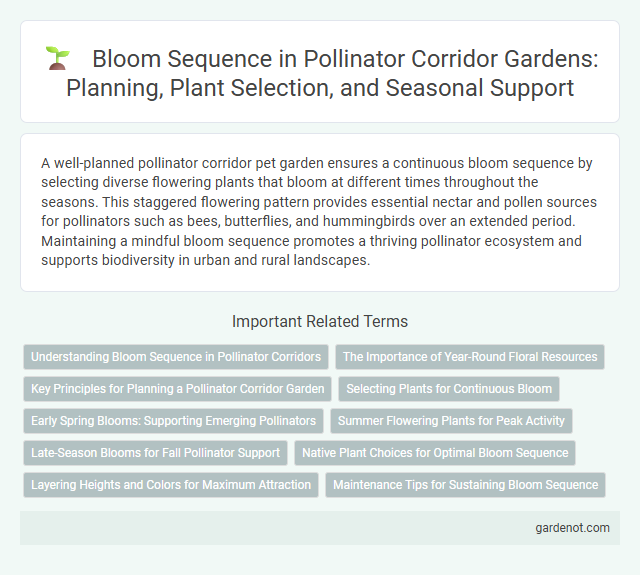A well-planned pollinator corridor pet garden ensures a continuous bloom sequence by selecting diverse flowering plants that bloom at different times throughout the seasons. This staggered flowering pattern provides essential nectar and pollen sources for pollinators such as bees, butterflies, and hummingbirds over an extended period. Maintaining a mindful bloom sequence promotes a thriving pollinator ecosystem and supports biodiversity in urban and rural landscapes.
Understanding Bloom Sequence in Pollinator Corridors
Understanding bloom sequence in pollinator corridors is crucial for ensuring continuous nectar and pollen availability throughout the growing season. Early, mid, and late-season flowering plants must be strategically arranged to support diverse pollinator species from spring to fall. This temporal stagger in bloom periods enhances habitat quality, promoting pollinator health and biodiversity within corridor ecosystems.
The Importance of Year-Round Floral Resources
A well-designed pollinator corridor ensures a continuous bloom sequence by providing year-round floral resources critical for sustaining diverse pollinator populations. Seasonal plant diversity supports species-specific feeding habits and life cycles, reducing starvation risks during resource-scarce periods. Continuous flowering not only stabilizes pollinator ecosystems but also enhances crop pollination and biodiversity resilience.
Key Principles for Planning a Pollinator Corridor Garden
Selecting a diverse bloom sequence ensures continuous floral resources, supporting pollinators throughout their active seasons. Incorporate native, locally adapted plant species to maximize nectar and pollen availability and enhance habitat connectivity. Strategically stagger flowering times by layering early, mid, and late bloomers promotes sustained forage and encourages diverse pollinator visitation.
Selecting Plants for Continuous Bloom
Selecting plants with staggered bloom periods ensures a continuous source of nectar and pollen for pollinators throughout the growing season. Prioritize native wildflowers, shrubs, and trees known for extended or successive flowering times to maintain habitat connectivity and food availability. Incorporating species such as coneflowers, goldenrod, and milkweed supports diverse pollinator species by providing sequential blooms from spring to fall.
Early Spring Blooms: Supporting Emerging Pollinators
Early spring blooms like crocus, snowdrops, and witch hazel provide crucial nectar and pollen sources for emerging pollinators such as bees and butterflies coming out of hibernation. These early floral resources support pollinator energy needs and reproductive success, ensuring population stability. Incorporating a diverse range of native early-blooming plants in pollinator corridors enhances habitat connectivity and promotes ecosystem resilience.
Summer Flowering Plants for Peak Activity
Summer flowering plants such as milkweed, coneflowers, and bee balm provide crucial nectar and pollen resources during peak pollinator activity months from June to August. Establishing a diverse bloom sequence ensures continuous food supply, supporting bees, butterflies, and hummingbirds throughout the hottest season. Strategic planting of native species with staggered flowering times maximizes pollinator corridor effectiveness and enhances ecosystem resilience.
Late-Season Blooms for Fall Pollinator Support
Late-season blooms such as asters, goldenrod, and Joe-Pye weed provide critical nectar and pollen resources for pollinators preparing for overwintering or migration. These fall-flowering plants extend the foraging period, supporting bee, butterfly, and moth populations when other floral resources have dwindled. Incorporating diverse late-blooming species in pollinator corridors enhances ecosystem resilience and promotes sustained pollinator health through autumn months.
Native Plant Choices for Optimal Bloom Sequence
Selecting native plants for a pollinator corridor ensures a continuous bloom sequence that supports diverse pollinator species throughout the growing season. Early-blooming species like Solidago spp. and Asclepias tuberosa provide vital nectar in spring, while mid-season blooms such as Echinacea purpurea and Rudbeckia hirta sustain pollinators during summer. Late-season natives, including Symphyotrichum novae-angliae and Helianthus maximiliani, extend foraging opportunities into fall, enhancing habitat resilience and pollinator health.
Layering Heights and Colors for Maximum Attraction
Strategically layering plant heights in a pollinator corridor creates a multi-dimensional habitat that supports diverse pollinator species, maximizing their foraging efficiency. Incorporating a vibrant spectrum of flower colors throughout the bloom sequence enhances visual attraction, drawing in a wider variety of pollinators such as bees, butterflies, and hummingbirds. This combination of vertical structure and color diversity optimizes ecological connectivity and pollination success across the habitat.
Maintenance Tips for Sustaining Bloom Sequence
Maintaining a continuous bloom sequence in a pollinator corridor requires regular pruning to remove spent flowers, encouraging new growth and prolonged flowering periods. Soil health must be monitored and enhanced with organic compost to supply essential nutrients that support diverse plant species in different bloom stages. Seasonal mulching helps retain moisture and control weeds, reducing stress on plants and ensuring consistent flowering that attracts and sustains pollinators throughout the growing season.
Bloom sequence Infographic

 gardenot.com
gardenot.com